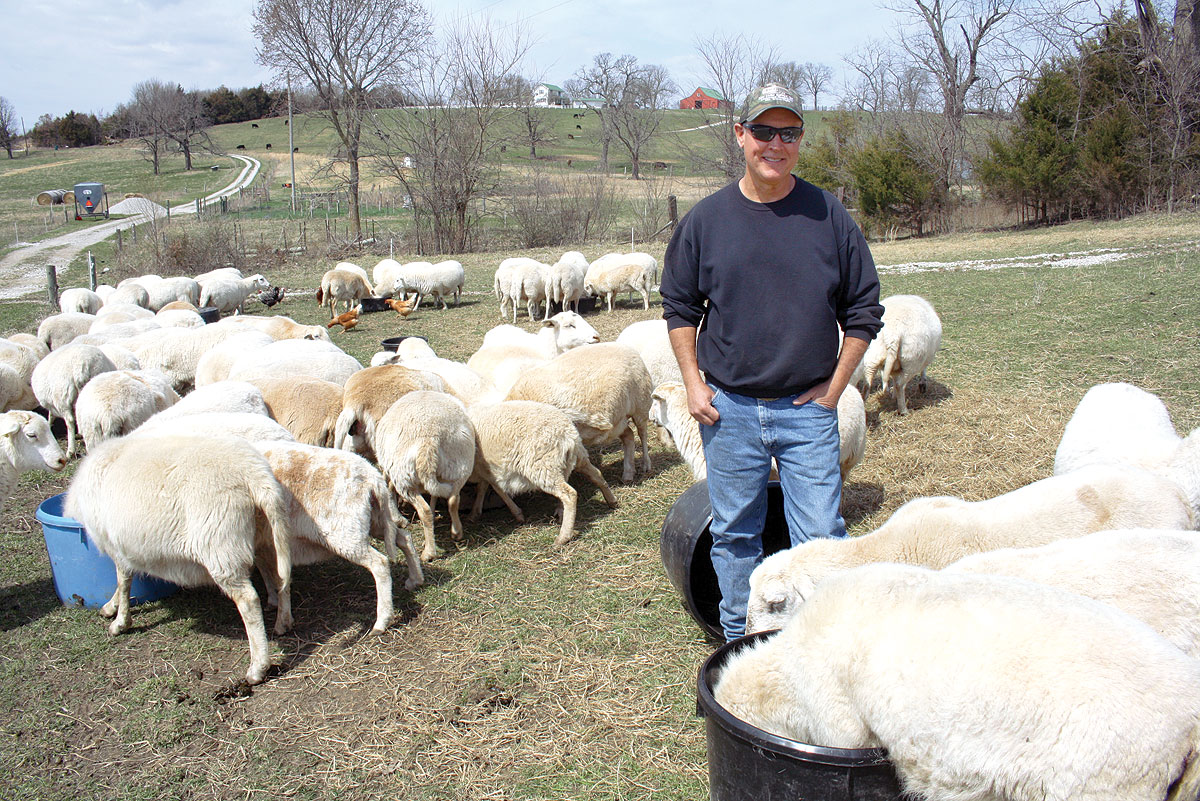
For the Mauldins, limited inputs help maximize returns
As Randy Mauldin neared retirement from the military, he began to ponder about the next chapter in his life.
“I told my wife (Beth) I wanted to be a farmer,” Randy said. “She laughed and said it was crazy, but after a while she saw I was serious. She loves it more than I do now.”
After a couple of years of research and reading dozens of books about farming and sustainable agriculture, Randy and Beth purchased a 70-acre farm near Fair Grove, Mo., and Fair Earth Farm was born.
“I could have gotten a job with Boeing, LockHeed Martin or somewhere like that, but Beth and I like the country lifestyle,” the retired U.S. Air Force colonel said. “Both of our grandparents had farms, so we grew up around agriculture, but didn’t have any family who lived where we could have a farm, so we picked a place in the middle.”
Randy and Beth initially considered a cattle operation, but after speaking with University of Missouri Extension Field Specialists in Agriculture Business Wesley Tucker while still in Virginia, the couple decided to hedge their bets on sheep.
“He said we’d pretty much lose our shirts in cattle,” Randy recalled. “He said to look into small ruminants, so I started to do some research.”
While still in the military, the plans began to come together, and Randy even traveled from Virginia to attend a grazing school in Bois D’Arc, Mo.
The Mauldins moved to the Ozarks in 2013 and opted for Katahdin sheep because of the breed’s parasite resistance, maternal traits and overall hardiness.
“It was an economic decision,” Randy said.
The first year of sheep production, however, was not a profitable one. They lost 40 percent of their lamb crop to parasites.
Randy attended a seminar with Dr. Charlotte Clifford-Rathert, DVM, associate professor of Extension at Lincoln University in Missouri and state small ruminant specialist, he said “revolutionized” how things were done at the Fair Earth Farm.
“She explained that parasites live in the gut, the sheep poop it out and it takes five days for the parasites to crawl up that blade of grass, then the sheep eats it and it causes an infestation. The strategy is to prevent it rather than treat.”
Thanks to some help from the Natural Resources Conservation Service, the couple implemented a rotational grazing system through the Environmental Quality Incentives Program (EQUIP), which also aided in the decommission of an abandoned well and the placement of waterers. Sheep are now moved every two to three days to a clean paddock. The 19-paddock system on 50 acres gives each paddock a 38-day “rest,” which breaks the lifecycle of parasites, eliminating the need for deworming of the flock.
“We haven’t lost a sheep to parasites since 2016,” Randy said. “We wormed the first year, but it was ineffective because the worms had built up a resistance to the wormer.”
He added that a rotational grazing system also reduces or eliminates foot rot issues.
“We have never had a case of foot rot and it’s because the sheep don’t stand around in poop and mud,” Randy said. “We have a hoof trimming schedule and we trim once a year.”
Randy and Beth, who is a teacher in the Fair Grove School District, utilize other programs from the NRCS, such as the planting of pollinating trees to establish an orchard and shrubs to deter erosion, as well as improve wildlife habitat and aid in future honey production. They are also in a grazing management program.
Their first flock was 24 ewes and they retained their females until they reached 125 ewes and three rams. Last year’s drought conditions forced the Mauldins to reduce their flock to 98 ewes, including 10 ewe lambs.
The couple turns their registered rams in with ewes around Nov. 8, and because rams are pulled prior to the ewe lambs becoming sexually mature, typically around 6 to 8 months of age, young ewes remain the main flock.
Lambing season begins in early April and ewes receive a 50/50 mixture of whole corn and dried distillers grain during the last month of gestation. The feeding program continues through the first two months of the ewes’ lactation. The rest of the year they are completely grass fed, with hay, which is grass/legume mix purchased locally, provided as needed.
“If the ewes don’t get that extra nutrition when they need it, the lambs can be sickly and die,” Randy said. “I see it as an investment and it works great.”
The Mauldin’s average about 1.8 lambs per year, but Randy expects that average to decline slightly this lambing season because of the drought conditions last year.
As part of their low-inputs management strategy, the couple administers no vaccinations to their flock and would rather keep out of the direct marketing of meat.
“Beth and I put about 700 hours of work into the sheep a year, and if we did the gig of people coming to the farm to buy one leg of lamb or if I tried to sell them to a restaurant, that’s more time invested,” Randy said.
Bottle-fed lambs are quickly sold, which also helps reduce required inputs, and ewes are culled if they produce only singles two years in a row.
Ewe lambs not retailed for the Fair Earth Farm are sold as replacement ewes, and ram lambs are typically sold through Buffalo Livestock Market in nearby Buffalo, Mo.
Another part of the low-input plan is that investments made for the farm must be economically beneficial. For example, a portable bulk feed bin is utilized instead of bagged feed, and they use a garden wagon to transport buckets of feed, and other items around the farm.
“This wagon cost $110,” Randy said with a laugh. “It doesn’t rust, rot or depreciate.
“When we first moved here, I thought we needed a big barn. After talking some people, I learned if you lamb at the right time of year, you don’t need a barn. The lambs are born on pasture and that’s $40,000 we didn’t have to spend. I think it’s important the decisions you make are economically driven.”
With no background in farming or raising sheep, the couple knew they needed to reach out to local experts.
“The first year we were here, I was building the exterior fence and was really enjoying it, but I just kept thinking, ‘What if I had a mentor who could help me with some of the questions I had?’” Randy said. “I was buying some sheep from a lady who said to get in contact with the NRCS because that’s their job. I got a hold of Adam Coulter (NRCS resource conservationist) and he started teaching me all of this stuff.
“Learning how to do a farm correctly is the key to having an efficient farm. I read 25 books before I even got here, then talking to people is important. What they tell you might not always be right or applicable to you, but education is huge.”
The couple would like to expand their flock, 125 ewes is the limit for the operation.
“That’s all we can do without hurting the land,” he said. “When I talk to my cattle buddies, I’m pretty vocal that they can make more money with sheep… I laugh all the way to the bank.”






